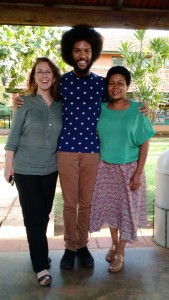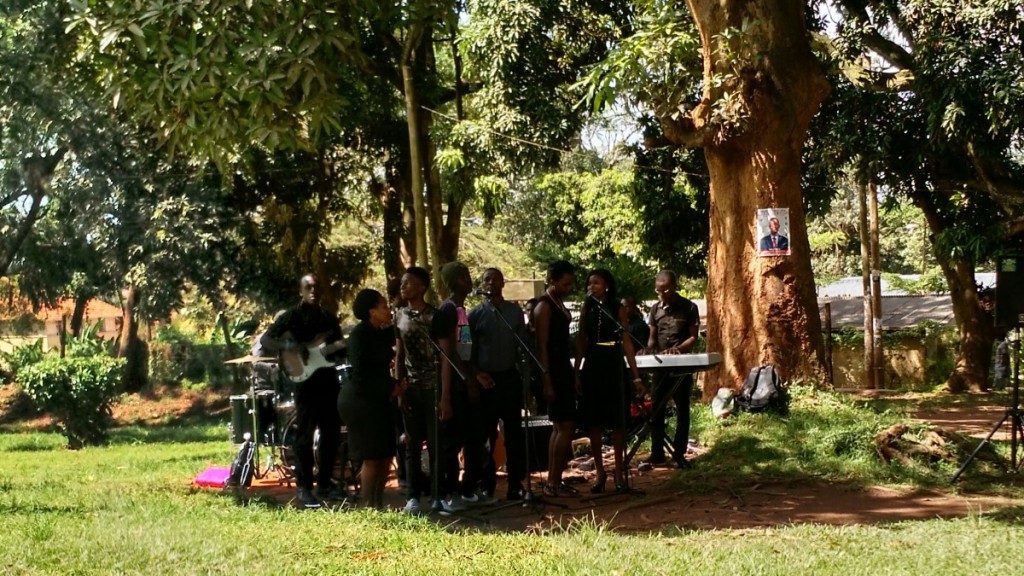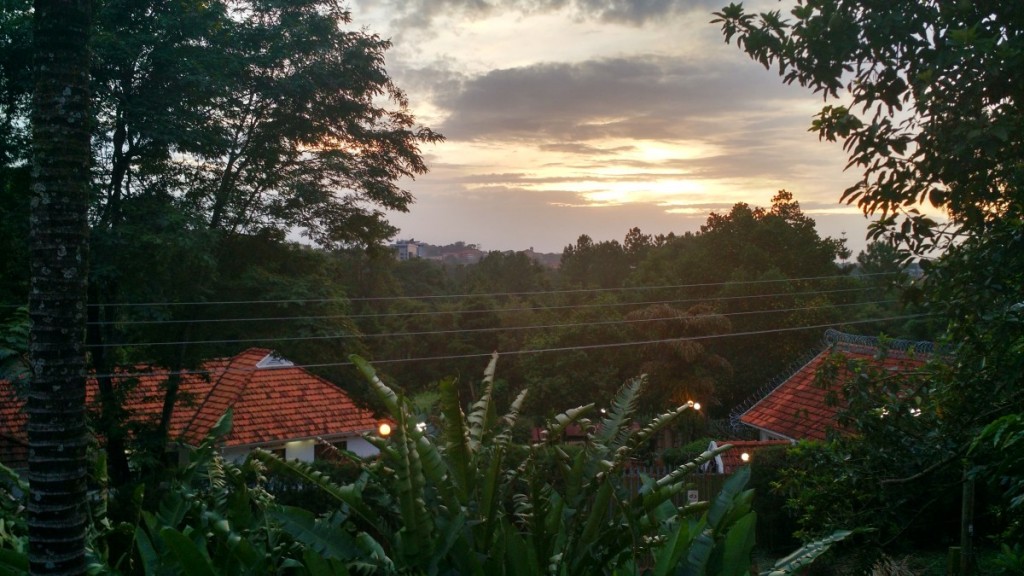This week I started working at the International School of Uganda (ISU). I have been helping out Rita in the upper school (middle and high school) music classes. The classroom is a great example of the combination of musical styles in Kampala. There are shelves with guitars, flutes, clarinets, saxophones and trumpets alongside adungus, endingidis and a few drums.
On Thursday of this week, I accompanied Jill, one of the teachers at ISU, to Makerere University. In addition to working at ISU, Jill also teaches dance at Makerere. One of the interesting projects she is working on at the moment is a collaboration between her dance class at Makerere and the Norwegian College of Dance. They are putting on a performance on the 2nd and 3rd of May which I am planning to attend. She also does an annual collaboration with the dance department at NYU.
After she finished her class at Makerere, I went with Jill to In Movement where they were rehearsing for the Norwegian College of Dance collaboration. In Movement is an organization that provides arts education to youth in Uganda. On the same property is ’32º East: Ugandan Arts Trust.’ This organizations goal is to provide resources for the development of an arts community in Uganda. They have several artists in residence and have held several exhibitions throughout Kampala over the years. One of the exhibitions I found particularly interesting was a mobile exhibit called ‘The Boda Boda project.’ Boda bodas are motorcycle taxis that provide a significant amount of public transportation throughout Kampala and other urban centers in Uganda. The project featured 20 artists who each created an installation utilizing a boda boda. The exhibition then traveled around Kampala and was on display in different locations over the course of the 2014 Kampala Contemporary Art Festival.
After returning to the University campus I was able to make an appointment to meet with Professor Sylvia Nannyonga-Tamusuza next week. The week I have been reading the book Ethnomusicology in East Africa: Perspectives from Uganda and Beyond which she edited along with Thomas Solomon. The article Professor Nannyonga-Tamusuza contributed to the book is titled What is “African Music”? Conceptualisations of “African Music” in Bergen (Norway) and Uppsala (Sweden). In her study, she focused on how people in Bergen and Uppsala perceive music from Africa and music that is marketed as such. Part of her argument is that “the term ‘African music’ is a brand name, an economic (popularised by the media as commercial product), political, and academic construct” (Nannyonga Tamusuza 204). I interpreted her analysis as a response to the use of the term as way of commodifying musics from Africa as “homogeneous, original, traditional, authentic, romantic, exotic, simple and natural” (Nannyonga Tamusuza 206). I am going to explore some of the sources she cites in her paper and try to provide further insights into this topic.
While on the Makerere campus, I was also able to hear a performance by a class studying popular music. The played an array of American and Ugandan popular music including a cover of Cindi Lauper’s ‘True Colors.’
I also made a trip to the Uganda National Museum. Fortunately the museum is pretty close to where I am staying so I was able to walk there. When I got there the first place I stumbled upon was the Library of the Uganda Society. The Uganda Society was “founded in 1923 as the Uganda literary and scientific society.” The librarian was extremely helpful and found a couple of books on Ugandan music for me. I spent some time looking over a book called African Music from the Source of the Nile by Joseph Kyagambiddwa. The book was published in 1955 so it is fairly old but had a lot of interesting information about Baganda music and had a rather large collection of scores and descriptions of the music. I am looking for a copy of the book online and will hopefully be able to find one that I can get back in the US. I also picked up a copy of Volume 53 of the Uganda Journal which is a publication released by the Uganda Society. There is an interesting article in this edition titled Music in the Sacred Forest of the Rwenzori by Vanna Viola Crupi. The article discusses how the Bakonzo people who live in the region relate to the environment through music and how this relationship has been altered by the designation of the Rwenzori mountains as a National Park.
After spending some time in the library, I made my way to the museum itself. One of the first exhibits I found was a display of the traditional instruments of Uganda. They had all the instruments arranged by type (drums, flutes, horns, bells, harps, etc.) and within each category they presented instruments from different tribes in Uganda. One instrument I am particularly interested in is the agwara from the West Nile region of Uganda. These trumpets are usually in a set of 7, each of which sound a different pitch. Each player plays a specific pattern which fit together to create a song. The Ndere Troupe played a song with the agwara at the performance I went to last week in which they broke the piece down into its individual components. Another really interesting instrument was a clay drum from the Bagisu of Eastern Uganda. I haven’t been able to find out anything else about it but I will continue digging.
This week I also made some additional observations regarding the soundscape. All over the city I had been hearing this wonderfully rhythmic hooo hooo hoo-oo hoo hoo that always made me want to dance. I was able to look through a book of East African birds that I borrowed from Cathy (the friend I am staying with) and discovered that it was the red-eyed dove that was making the call. I have been having difficulty getting a good recording of it but I will include one once I can.
I have also begun to hear, in addition to the roosters and other birds I hear every morning, a Muezzin calling for morning prayer from one of Kampala’s mosques. I’m not sure exactly where this mosque is but I’m sure I will stumble upon it while wandering around the area.
Here are a few songs that I have listened to over the past week:
Bwendifa – Ndere Troupe
Abedo kena kena – Ndere Troupe




Henry,
I have to compliment you for how engaging and thoughtful your post is. I think it’s quite commendable to be able to so eloquently integrate so much information into such a compact, interesting post. In addition to that, I’m incredibly glad that I caught this post in particular, as you seem to have found a connection in Africa to my musical city in Norway, Bergen! You speak about the Norwegian School of Dance integrating their dance with the Makrere school, and I would love to hear more about that. Which are they using as a basis? Would there be a way that I could watch a video of it? I’m very interested in just how connected the two cultures/schools are and are going to be by the end of this endeavor.
I’m also wondering more about the sound that the agwara. You call it a trumpet, but I’m wondering how similar its sound actually is to a trumpet. Do you call it a trumpet because of the sound it produces or because of the way the sound is produced?
The bird that you mentioned towards the end of your post, the “red-eyed dove,” sounds very intriguing. Is there an animal that sounds similar to it? Also, is it constantly rhythmic or is it more of a spaced out between its rhythmic outbursts?
Lots of questions, but your trip is so wonderfully fascinating that I have trouble not wanting to know more. I am anticipating your next post with great excitement.
I absolutely LOVE reading your posts. The world you are living in right now is so vastly different from mine, it’s pretty crazy to me that we are even in the same class right now! Reading this post really helped me reevaluate how I’ve been studying flamenco over here and helped to pull me out of a period of feeling really lethargic – so thanks!
I read in your last post that people there speak many different languages, but that a lot of people speak English. Do the kids at the school speak English? I was also really curious about your experience in the library! Are many of the books there in English? Are you learning a bit of Kiswahili? Language has been a really interesting part of my trip here. I know a decent amount of Spanish but not Spain Spainish, if that makes sense. Here, you can not only tell where someone is from by their accent but you can even tell how much money they have and what village they are from. Have you noticed class distictions by language and accent?
I really enjoyed the music that you included, especially the song by the Ndere Troupe. They’ve been officially added to my playlist. Seeing them must have been incredible! Can’t wait to read your next post!
Hey Henry,
Awesome that you got to see your elementary school teachers again. I’m sure that was a weirdly awesome moment for both you and them. I am not sure but I’m guessing that the roads in Uganda tend to be quite wide and the terrain flat? That’s the only way I could imagine a motorcycle taxi working well. That’s actually an excellent idea, having a boda-boda sounds like it would save money on gas for the taxi driver and thus bring the fares down a considerable amount for the passenger.
Over-all it sounds like you’ve learned quite a bit from the trip already almost half-way into it. That’s awesome. I’ve always wanted to play rhythmic instruments so I envy your current selection. Hope you have a good weekend and I’m looking forwards to the next post.